

Science in agriculture
Quotation 1—The modern farm
Most farms are family farms. “In 2010 of all the farms in the United States with at least $1 million in revenues, 88 percent were family farms, and they accounted for 79 percent of production. Large-scale farmers today are sophisticated businesspeople who use GPS equipment to guide their combines, biotechnology to boost their yields, and futures contracts to hedge their risk. They are also pretty rich.”
—Chrystia Freeland. August 1, 2012. “The Triumph of the Family Farm.” The Atlantic.
Innovation without science
Before describing the role of science in agricultural progress, let it first be known that much innovation can, has, and will be done without formal scientific institutions. Great inventors and perpetual tinkers often have no need for a scientific background; their own panoramic imagination and practical skills can suffice. From the time of hunter-gatherers,
(NOTE edit to the left) humans have sought to make their lives easier by coming up with new ideas and improving upon old ones. Given the importance of agriculture, and the heavy physical burden it placed on our ancestors, it should not be surprising that they pursued better ways of making food.
Someone, likely a female, had the idea of deliberately putting seeds into the ground so that a plant willwould (NOTE edit to the left) grow, to be harvested later. Millennia later, we have agronomy. Another, perhaps a male, thought it a keen idea to keep livestock cornered in a canyon instead of having to track them for miles on a hunt. Millennia later, we have domesticated livestock.
Figure 1—Horses pulling a heavy-wheel plow
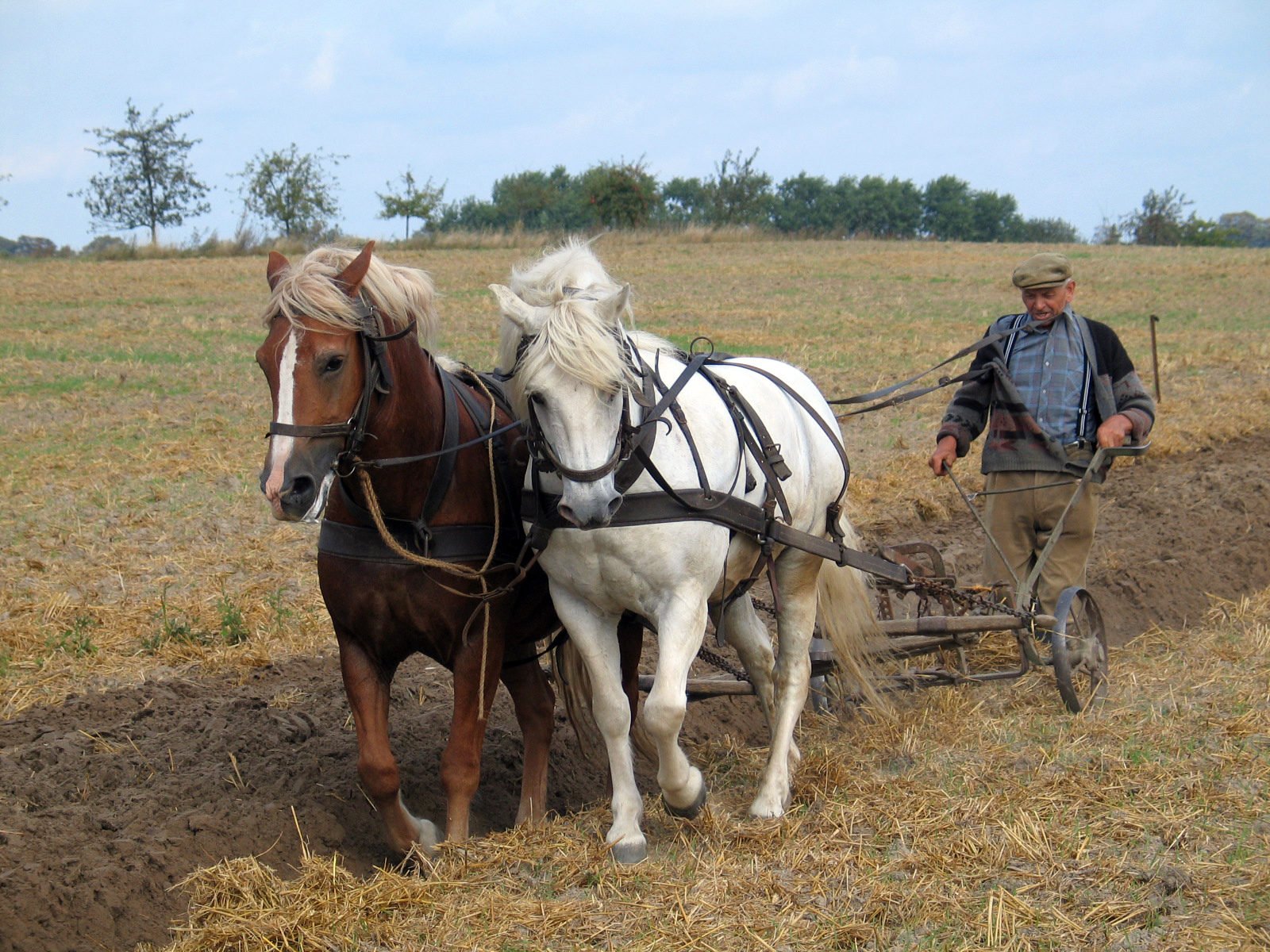
From those two great ideas, fast forward thousands of years later to the 10th 11th (NOTE edit to the left) century AD, where two great ideas changed the nature of agriculture forever. These are the heavy-wheeled plow and the horse-collar. With this plow, the soil could be broken at a greater depth, and the horse-collar finally allowed horses to pull plows without choking.(A1,D1) There was no “science” driving these innovations. Science as we know it didn’t exist, and the educational institutions that did exist were focused almost exclusively on foreign languages, rhetoric, religion, (NOTE edit to the left) and history. The future seemed irrelevant to the highest forms of education, and engineering was more of a trade, learned through apprenticeship and experience. Even in the absence of scientific institutions humans innovated and created new tools and practices. That said, agriculture has accomplished things that would be impossible without the scientific research institutions of today and the public educational system that passes the scientific method and theories down to the next generation.
Quotation 2—On horses and plows
“Peasants pooled their pence to buy a plow or harrow for their common use. Till the eleventh century the ox was the draft animal; he ate less expensively, and in old age could be eaten more profitably than the horse. But around 1000 the harness makers invented the stiff colar that would allow a horse to draw a load without choking; so dressed, the horse could plot three or four times as much in a day as the ox ...”
—Durant, Will. 1950. The Age of Faith. The Story of Civilization. Page 559.
A familiar agricultural revolution
The words “agricultural revolution” get thrown around a lot (especially by me). Typically, when people say “agricultural revolution” they are either referring to the Neolithic period when people learned to farm, or the 19th century when mechanization in agriculture began.
I want to talk first about an agricultural revolution in ancient China, around the 1st century BC. The technologies used today may be vastly different from the ancient Chinese, but the social conditions necessary for technological progress are not. China at this time was fortunate to have good rulers. In some ways they were the same as other, harsher rulers, who would inspire the term “oriental despotism”: these rulers sought power, hegemony over a large area, and riches. What was different is that the rulers around the 1st century BC understood how wealth is created, and they used it to their advantage.
- First, they kept taxes on land low, so that farmers had the incentive to work harder and become more productive.
- Second, market prices were allowed to fluctuate (for the most part), so that market forces could dictate to farmers what should be planted, and where. If more rice was needed, the price of rice would rise. Seeing a profit opportunity, farmers would respond by planting more rice, thereby correcting for the rice shortage. Sometimes the best cure for high prices is high prices.
- Third, the government subsidized the acquisition and dissemination of knowledge, resembling the modern land grant university system in the U.S. Scholars wrote books and encyclopedias of agriculture, research was conducted, and scholars were sent out into the country to teach the peasant farmers what they had learned. These scholars also learned from the peasants, including information on alternative farming techniques and new plant species.
- Finally, the government invested in large-scale public infrastructure, like irrigation and grain storage.
The results were astounding. Farmers learned how to
- double-crop.
- treat seeds so that they would not germinate until the next planting.
- better irrigate rice, and recirculate water.
- use mulch to keep the ground from drying.
- use cover crops.
- produce better iron implements.
- employ new fermentation and pickling technologies.(A2)
Take a look at the modern Land Grant University, along with the experiment stations and extension educators they support, and you might suspect them of emulating ancient China.
The U.S. Land Grant System
In his 1796 presidential address, George Washington called for a board of agriculture at the federal level that would encourage experimentation with farming methods. Individual farms always have performed their own, small experiments, but rarely are they scientifically rigorous. Even if they did employ the scientific method, the costs are born by the individual farmer, while the benefits are shared with everyone, thereby discouraging any indvidual from experimenting. Some like Edward Ruffin did it anyway, testifying to the fact that there will always be some individuals willing to sacrifice their time for the common good. Because there are few Edward Ruffins in the world, many farmers recognized the need for large-scale experiments whose costs are would be (NOTE edit to the left) borne by all. Until government-sponsored programs, this need was partially met by the establishment of agricultural clubs, where farmers could convene to trade ideas and share the results of their experiments. This voluntary, decentralized market for ideas may have yielded fruits, but many still called for more ambitious research funded by the government.(E1,K1)
One such club, created in 1894, still exists in my hometown of Barnwell, S.C. Initially created to procure and spread knowledge, the decline of agriculture in the region has altered its ambitions. Now, the club meets once a month largely to eat a local recipe for pork barbeque and hash. Their roots nevertheless remain in their 1894 by-laws though. Before eating, a guest speaks about an agricultural subject, and they still do not allow female members.
Quotation 3—Stated purpose of Ellenton Agricultural Club (1894)
“To take such measures as might be deemed advisable in promoting the interest and the welfare of our farmers, and for the greater increase and diffusion of knowledge upon subjects that tend to the betterment of their condition generally as an agricultural people.”
Figure 2—Ellenton Agricultural Club in Barnwell, S.C.
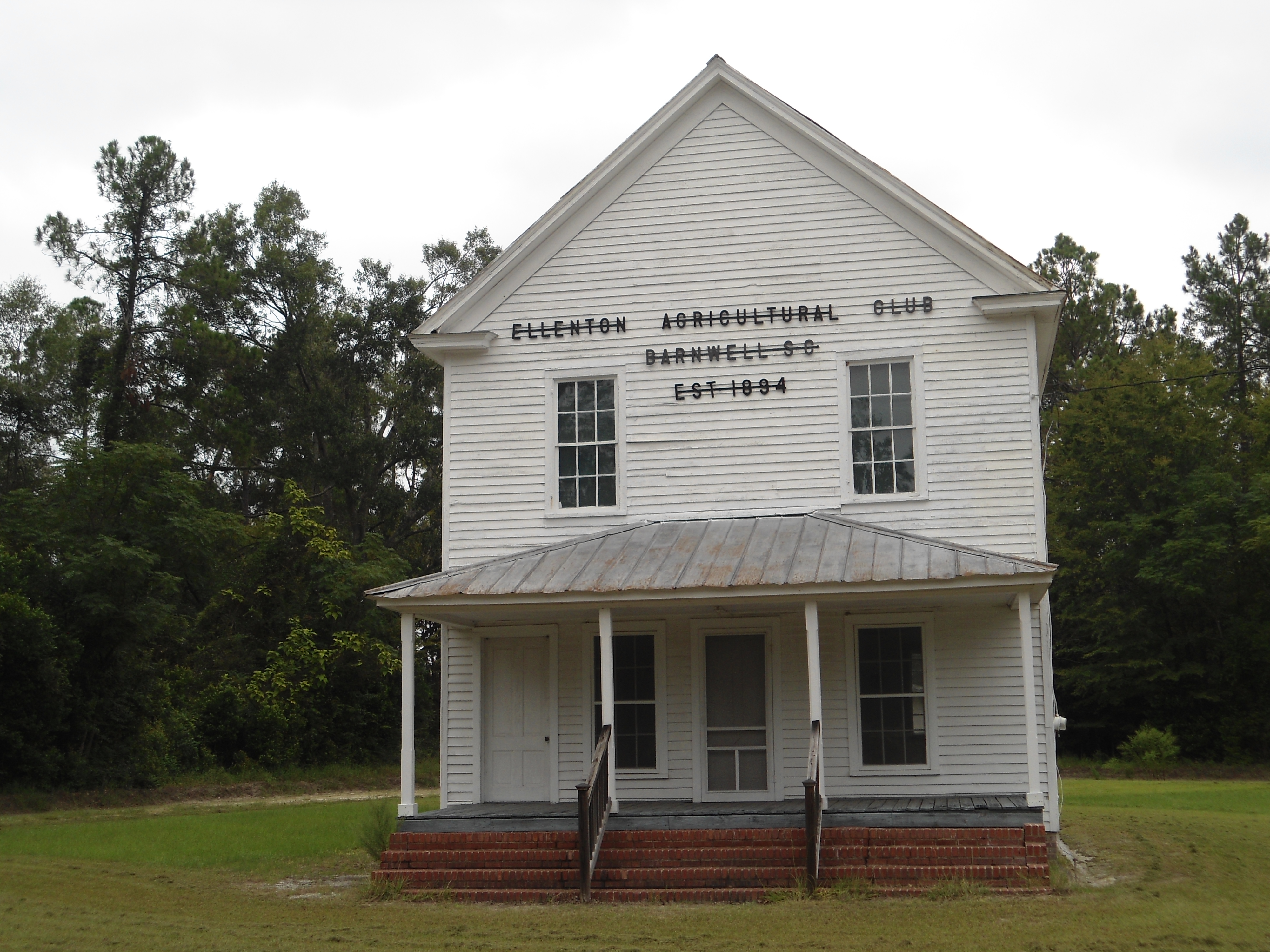
George Washington’s idea for federally-sponsored agricultural research never went anywhere until the Civil War, for its creation threatened the balance of power between state and federal governments. Washington’s peers felt that it would be an unconstitutional reach of federal power, and was an idea that should be left up for the states themselves to accomplish.
Around 1840, there began a serious debate on the extent to which scientific experimentation even could improve farming. Americans saw Europe making progress, and they worried that political friction was holding U.S. agriculture back. One might say that modern agronomy began in 1840 Germany, with the publication of Justus von Liebig’s Organic Chemistry and its Applications. Throughout the 19th century, Germany would be the leader in agricultural science, where its 70+ government-funded experimental farms gave them a hegemony in the knowledge of crop production. Liebig constructed a theory of plant growth that suggested a field could remain in perpetual fertility by chemically analyzing the soil and restoring the proper balance of nutrients, and Germany's experimental farms suggested that theory was correct.
Liebig spelled out the necessary plant nutrients as being nitrogen, phosphorus, and potassium, and other micronutrients of lesser importance—this idea is accepted fact today. He thought that phosphorus was the most important nutrient for growth, and set about finding ways of adding it to the soil, like by dissolving bones in sulfuric acid. Not much attention was paid to nitrogen, as Liebig believed enough was made available from rain and snow that there was little need to acquire artificial sources.
A Purdue University agronomist would prove Liebig wrong on nitrogen by applying it in chemical-form to grass outside of his dean’s window. The nitrogen was sprayed such that, when the grass responded to the nitrogen by surging upwards, it plainly spelled the word “nitrogen”. The dean was convinced, and eventually, everyone else was convinced also. (P1)
Back to Liebig. His work, along with experiments in Britain, got many in the agricultural community excited about the idea that science was going to usher in a revolution in farming. People latched onto the idea before science could really produce anything, though, and soon chemists began to really understand the complexity of the soil. This understanding suggested that chemical fertilizer would not be easy to manufacture. This reality-check split the agricultural community into two groups: one who believed science would eventually deliver results, if given the proper funding, and the other who did not.
Interest in “scientific agriculture” encouraged a number of businesses to begin selling chemical (or synthetic) fertilizer, much of it little more than snake-oil. Was this because all chemical fertilizer was snake-oil, or because some of (NOTE edit to the left) these businesses were peddling an inferior form of fertilizer? Many called on the government to test these fertilizers in scientific trials, so that farmers could obtain the information they needed to raise crops productively. (K1)
The scales were tipping in favor of federally-sponsored research in agriculture, but political friction between the North and the South still proved too strong. These scales were then made irrelevant when the South succeeded, and from the North's point-of-view, their votes no longer counted. A series of bills were then passed that became known as “Farmers’ Legislation.” One of these created what is now called the United States Department of Agriculture and another provided money for a nationwide system of agricultural colleges.
It took a number of bills to establish enough money to really make things happen, but between the 1862 Morrill Act and the 1887 Hatch Act there emerged a system where Land Grant Colleges administered experimental farms, offered agricultural degrees, and provided free public education on agriculture. The experimental farms are referred to as experiment stations, and those providing the public education are referred to as extension agents.(E1,K1)
Figure 3—Land-Grant Colleges and Universities
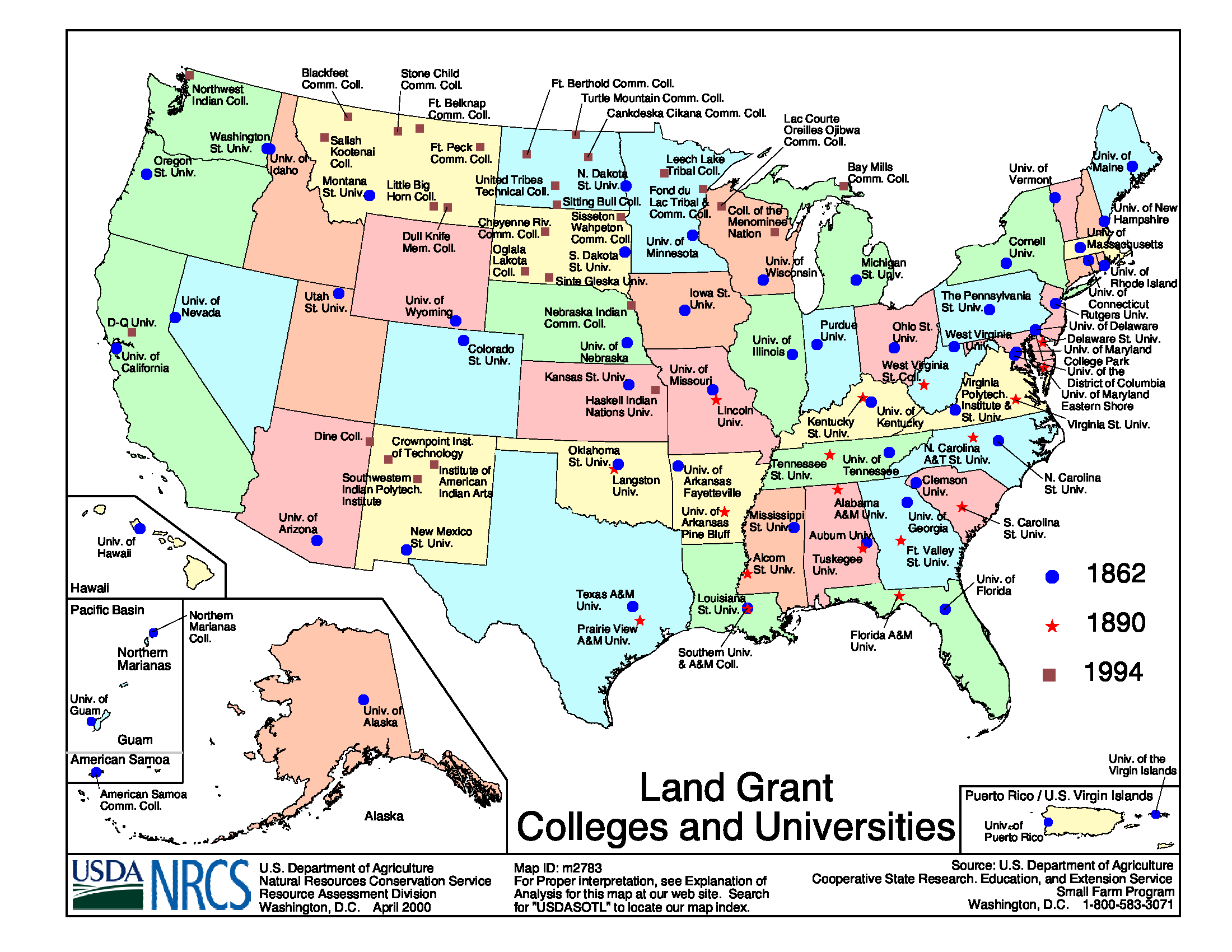
My university, Oklahoma State University, is one of these Land Grant Universities. We operate experimental farms throughout the state, and the extension service educates the public on what these experiments reveal. Most other states have a similar institution. In fact, if you are a fan of college football, you are familiar with most of them. If you look at the logo for my college you will see a triangle, and this is meant to represent the three missions of our college: research, teaching, and extension.
Figure 4—Logo of agricultural college at Oklahoma State University
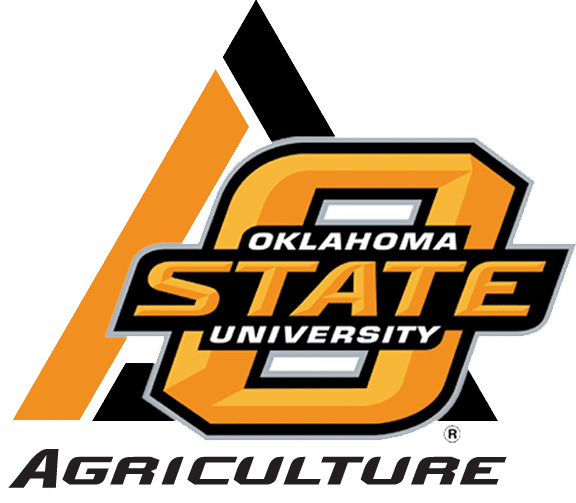
For an example of how government funded research can be more effective than voluntary efforts, consider what happened when West Virginia’s experiment station gave out free seed and planting information to farmers, asking the farmers to send them information on how well the seeds performed. If farmers complied it would provide a wealth of data on the performance of different seeds. Unfortunately, of the 708 farmers who took the seed, only 1 returned useful information and most (85%) did not even respond. This is why we needed experimental farms, rather than trying to coordinate lots of little experiments from many different farms.(K1)
Consider a few examples of how agricultural research has improved agricultural efficiency in the twentieth century.
Eggs
Before egg production became an “industry”, eggs were produced on many small farms, each having between 50 and 300 hens. Much about the farm may seem idyllic. Hens (called layers if used largely for egg production) were given shelter, and in bad weather this shelter provided up to four square feet per hen, compared to the 0.46 square feet most get today. The hens were allowed free access to the outside—not so much for their enjoyment, but because farmers had little choice. Before the 1950s, there was no feed that could supply all the hens’ nutrient needs, so they had to be let loose to secure these other nutrients (like certain vitamins, minerals, and amino acids) for themselves. Also, the hens needed sunlight for Vitamin D.
One could say these “free-range” hens led a natural life. Indeed, it so closely resembled nature that many of the hens were killed by predators! I once visited a free-range farm where the mortality rate was around 25%, and the farm didn’t have to worry about spent hens (hens that are so old and unproductive they are unprofitable to feed) because they rarely lived to an old age.
Scientific research in nutrition eventually taught us how to make complete chicken feeds, so that layers could be kept in cages, with no sunlight, for their entire lives. Farmers were taught by extension agents how to use trap cages where, when a hen came to her nest to lay an egg, it wouldn’t let her out until a farmer opened a door. This allowed the farmer to record which hens were laying eggs, thereby determining which hens were most productive. Farmers would then breed the productive hens but not the unproductive ones. Some eventually wondered why they would ever even let the hen out at all, and so they stopped, and the vast majority of layers in the U.S. were kept in cages—and have been ever since.
The idea of raising chickens in crowded barns with no sunlight is not new. Since ancient times humans have done so for young chickens raised for meat, but that is because those chickens were slaughtered at a young age. Laying hens live for much longer, and if kept out of the sun in crowded conditions, and without the complete feeds we have today, they would likely die. Notice in Seneca’s quote below that he specifically refers to poultry raised “for the table” and not for eggs.
Quotation 4—An ancient philosopher on raising chickens
Poultry that are being reared for the table are cooped up in the dark so as to prevent them moving about and make them fatten easily; there they languish, getting no exercise, with the swelling taking possession of their sluggish bodies and the inert fat creeping over them in their magnificent seclusion.
—Seneca, Lucius Annaeus (4 BC – 65 AD). Letters from a Stoic. Letter CXXII. Penguin Classics. Page 221.
Egg production today takes place in factory-like conditions, in that the farmer has considerable control over the amount, uniformity, and type of eggs she produces. Farmers can even determine the exact color of the egg yolk by adding different supplements to the hens’ feed. They have learned to increase production by leaving on lights after the sun would normally set, and keeping the barn at a comfortable temperature. Much of this research was performed by experimental farms, after which extension agents would spread out about the country educating farmers about the experiments’ results. Not all farmers paid close attention to agents. But the ones that did survived and got bigger, while the others went out of business.
Whether animal welfare is satisfactory on these farms is up for debate, but one cannot deny their productivity. In the 1930s, one hen would produce around 153 eggs per year. Today that number is 250, and most of this improvement has been given to consumers in the form of lower egg prices.(N1)
Figure 5—Egg prices over time
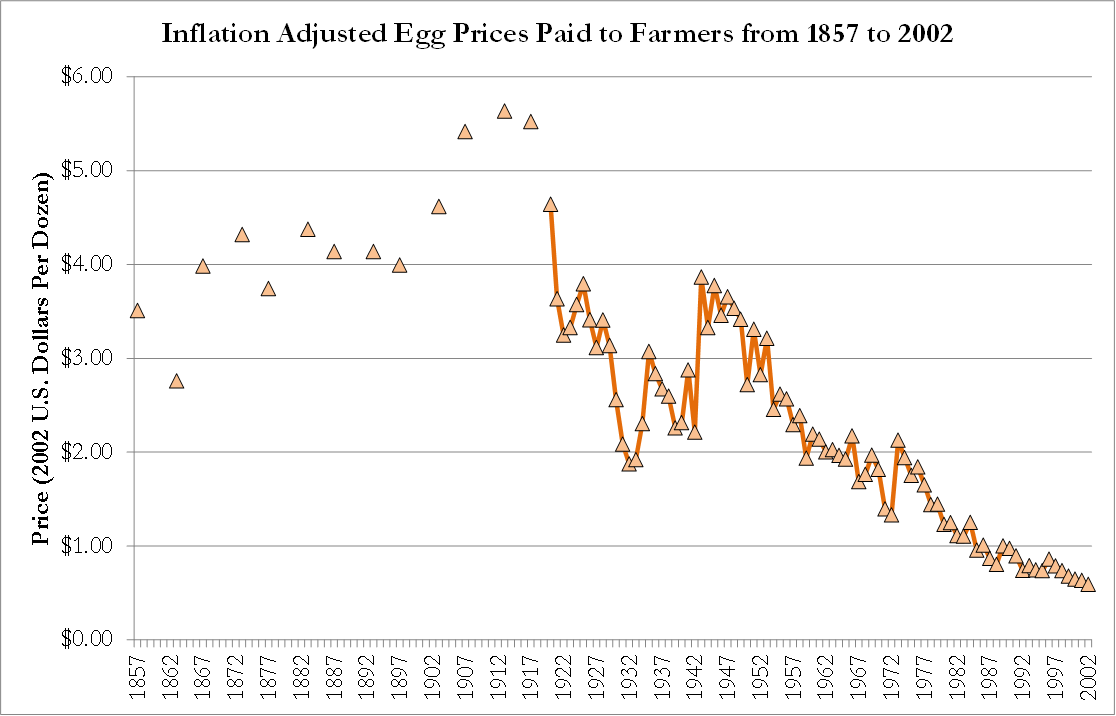
Corn
Frederick William I (1688-1740) was a Prussian king with a particular affinity for tall people. He sought to create an army of giants by instituting a breeding program where tall males and females were asked to procreate. Peter the Great (tsar of Russia) would send him 50 tall Russians every year to help maintain good diplomacy. The breeding program didn’t work. Most of the time it produced a person of an average height.(M3)
Similarly, farmers’ tried to create high-yielding corn varieties by planting the seeds of corn with particularly large ears. The Prussian king did not create giant soldiers, and farmers did not create giant corn. This isn’t because selection for certain genetic traits doesn’t alter the genes of the offspring. It does, but you have to give the process time, and both Frederick and corn farmers naively expected immediate results.
Scientists would later learn that producing high-yielding corn quickly was best achieved not by breeding two high yielding plants, but two different varieties of high-yielding plants—what we call “hybrid” varieties. It would be hard to find a bigger technological leap in agriculture than the development of hybrid corn. A hybrid variety simply refers to the mating of two different varieties of corn plants. Think of the Labradoodle, a mix between a Labrador Retriever and a Poodle, but replace the two dog breeds with two different corn varieties. The idea of deliberately raising hybrid plants started with Gregor Mendel in 1865, but it took some time for his ideas to be put into practice.
In 1919, a researcher at the Connecticut Agricultural Experiment Station developed the first commercial double-cross hybrid, using four inbred parents, which produced exceptionally high-yielding and healthy corn plants. The first of these varieties was made available in 1921, though it would take about fifteen years—and much groundwork on the behalf of extension agents—before farmers took them seriously. But when they did, corn yields surged upwards.(Y1)
Quotation 5—Book smarts versus street smarts
To be sure, suspicions of “book farming” lingered in the minds of many farmers. As late as 1913, 44 percent of farmers in a national survey reported that experience alone was valuable. Still, as agriculture became more specialized, less self-sufficient, and more oriented to the market, those farmers who hoped to remain prosperous depended increasingly on the knowledge discovered by agricultural science.
—Kerr, Norwood Allen. 1987. The Legacy: A Centennial History of the State Agricultural Experiment Stations 1887-1987. University of Missouri-Columbia and the Missouri Agricultural Experiment Station. Page 64.
Although there are many other reasons for the increase in corn yields over time, due to better corn genetics, between World War II and today the number of labor hours needed to produce 100 bushels of corn has fallen from 100 to 2 hours..(C1)
Figure 6—U.S. corn production and yields over time
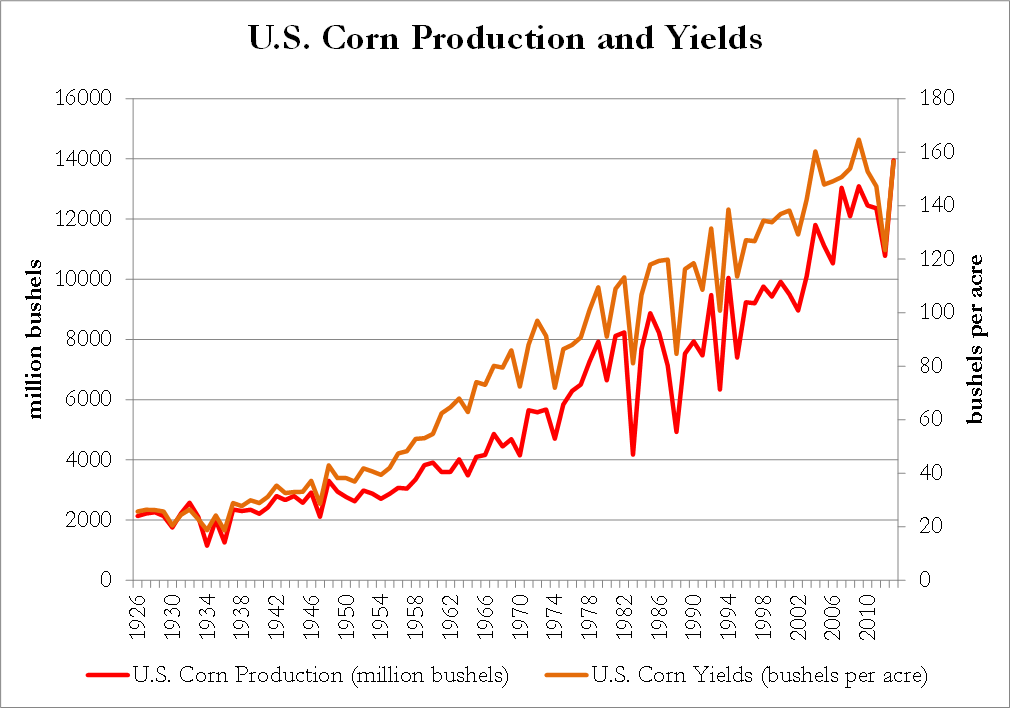
Broilers
A “broiler” used to refer to whole chickens in the grocery store weighing only 1.5 to 2.5 lbs. A century ago the same breed of birds were used for both egg and chicken production. The hens were reserved for eggs while the young males were raised for their meat. The term “broiler” came about because the chickens were small enough that you could split the spine, lay the chicken flat in an oven, and broil it. If the chickens were raised to a larger weight they might be called fryers (2.5 to 3.5 lbs in the grocery store) or roasters (3.5 to 5 lbs), both of which are too big to broil.
Some grocery stores still use these definitions, but the term “broiler” has also evolved to refer to a live chicken raised for meat. Today, the egg and broiler industry use different breeds. And don’t try to broil a chicken from the grocery store today. They are too big—you’ll just have a burnt outside and raw inside!
Figure 7—Modern broiler production
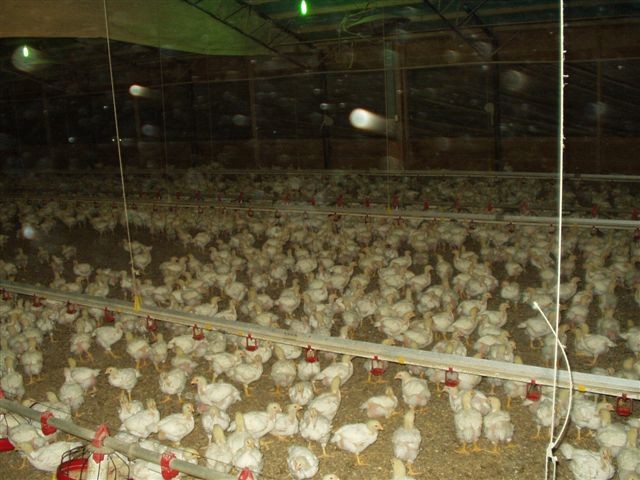
Most broilers are raised on the floor of an enclosed barn in very large flocks. The building is temperature-controlled and the lights are kept dim, so that the birds can find feed and water but won’t move around much.
The broiler sector really started becoming an industry soon after presidential candidate Herbert Hoover promised “A chicken in every pot.” A chicken was an indicator of prosperity, because it was more expensive than other meats at the time. After Georgia suffered agricultural difficulties in the 1920s, they looked to broiler production to simulate and diversity their economy. The state government provided money to the University of Georgia to develop and help farmers implement new production methods. Georgia’s Department of Agriculture even helped people build hatcheries and develop better breeds of birds specifically suited for meat production.
Yet it wasn’t just the government using science for increased productive efficiency; the private sector had their own momentum.
Private sector research
Following Georgia’s lead, the private sector jumped into the game and made their own contributions to broiler production. Food processors and retailers wanted farmers to improve their efficiency, produce more white meat per bird, and to produce a more consistent carcass. To encourage this, the retailer A&P (the Walmart of the 1940s) and the USDA partnered to host a Chicken of Tomorrow contest, where farmers submitted eggs and the A&P-USDA team would hatch and raise the chickens, doing everything possible to ensure all chickens were treated the same. The winners established a breeding business and their birds’ genetics were made available to all big broiler producers. These genetics, and the newly found understanding of how genetics can really boost efficiency, created the modern broiler—which is nothing short of amazing. It took almost 5 4 (NOTE edit to the left) lbs of feed to produce one pound of broiler in 1925; today it takes only 2 lbs.
Figure 8—Broiler productivity over time
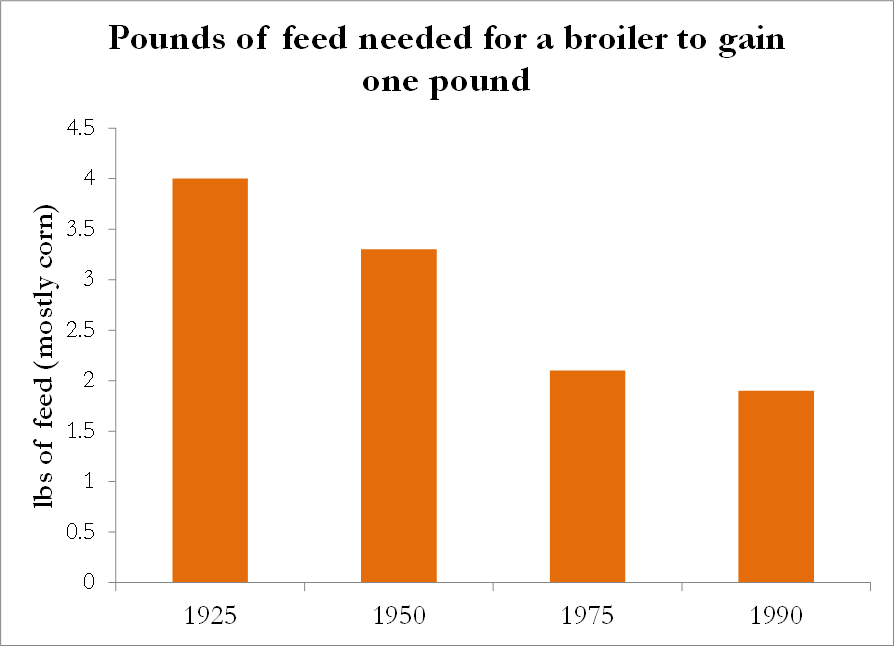
Genetically modified organisms (GMOs)
The crowning achievement of private sector research in agriculture is biotechnology. Regardless of how you feel about GMOs, one has to marvel that we are even able to do it. Whoever thought we would be able to manipulate a single gene in an organism?
When you think of GMOs, you think of Monsanto. In the 1970s, Monsanto became convinced that it might be possible to design plants that would exhibit certain traits, like a resistance to the herbicides that it sold, allowing a farmer to spray their pesticide Round Up all over a field, knowing it would kill everything except the crop. For over ten years, scientists at Monsanto pursued general research into genetic modification without having to worry about producing a profitable product. Their efforts did not go unrewarded. Monsanto learned how to use bacteria to transport a gene from one organism into another. Then a new CEO came in 1984 and made his intentions clear when he said, “We are not in the business of the pursuit of knowledge; we are in the business of the pursuit of product.” It was time to turn general scientific research into specific product development.
The heat was on to produce a soybean resistant to the herbicide Round Up (which uses the active ingredient glyphosate). This required one to find an organism with genes for resistance to glyphosate, and then to cut that gene out of the organism’s DNA and insert it into the DNA of a soybean plant. But where could they find an organism with that gene? It took two years of searching, but they finally found it in the garbage of one of their plants where Round Up was produced. There were decontamination ponds to treat the residues, and near those ponds they found a bacterium that had developed a resistance to the pesticide. They then figured out a way to isolate the bacteria’s gene responsible for the resistance, cut it out of the DNA, and insert it into a soybean’s DNA. After much effort and expense, in 1993 the Round Up Ready soybean was launched, then commercialized in 1996.(M1,R1)
Most soybean farmers today use this variety, and you are unlikely to see a weed in their fields because the Round Up they spray kills [virtually] every plant except the soybean. Today, most all soybeans, cotton, and corn are GMOs, designed to be herbicide tolerant (HT, in graph below), or to make its own insecticide (Bt). It is hardly an exaggeration to say that no private sector research has had more influence over the path of agriculture than Monsanto’s work in biotechnology.
Figure 9—Adoption of genetically modified crops in U.S.
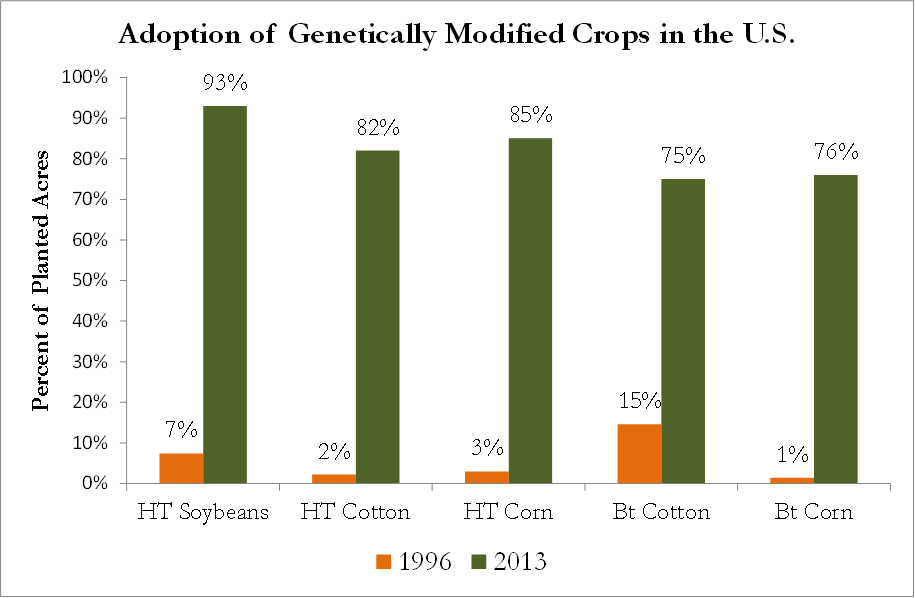
The Round Up Ready soybean may have been created by the corporation Monsanto, but the GMO process owes a considerable debt to public-funded research in general biology. Three microbiologists, Werner Arber, Hamilton Smith, and Daniel Nathans, seeking only to further our general understanding of biology, having no intention of producing better varieties of crops, discovered how one could dive into the cell of an organism, cut and withdraw a portion of its DNA, and splice it into the DNA of an entirely different organism.
Deserving of the Nobel Prize in Physiology or Medicine they won for their discoveries, their scientific research made possible the revolutionary crop varieties we have today.(S1) Monsanto may be a leader in the design of superior crops, but they have always followed the bread-crumbs left behind by scientists.
Quotation 6—A genetic revolution
It was 1973. These scientists had taken two chromosomes, cut them open, put them back together, and showed that they were functional in a cell. They had created genetically functional recombinant DNA ... It was a revolutionary discovery. It meant that genes from any sources in nature could be taken out of a cell ... and swapped and spliced ... We were no longer limited in genetics by normal processes such as fertilization ...
—Sadava, David. Understanding Genetics: DNA, Genes, and Their Real-World Application. Lecture 10: Manipulating Genes–Recombinant DNA. The Great Courses. The Teaching Company.
Location, location, location
New technologies like GMOs and complete animal feeds are not the only means for improving agricultural productivity. Wiser decisions about things like where to raise animals can enhance our food supply by just as much.
The modern feedlot sector emerged from the 1960s when aggressive cattlemen spent large amounts of time and research using computer programs (in the 1960s, mind you!) to determine the best location for a feedlot. The best land is a little hilly to help control runoff, but in a largely dry climate with moderate temperatures to keep cattle healthy and control flies.(B1) This is why so many feedlots are located in the dry, warm climate in the panhandles of Oklahoma and Texas.(NOTE edit to the left) Being close to slaughterhouses and sources of feed is also desirable, but it is rare for one location to have all these traits. In reality, the beef industry must make tradeoffs. In the past century, as feedlots shifted away from where corn was grown and closer to areas with better weather, the improvement in cattle health was worth the higher cost of acquiring grain. This has led to cheaper beef and possibly better animal welfare.
As firms developed more sophisticated tools for making logistical decisions, food production became more efficient and cheaper—just like the logistics employed by Walmart has made the price of everything cheaper, and that of UPS has made shipping packages cheaper.
After Rachel Carson
Most of the twentieth century was focused on improving agricultural productivity, but Rachel Carson’s book Silent Spring made Americans confront the fact that pesticides may reduce the cost of food production, but they also pose a number of health harms. As her book led to the creation of the Environmental Protection Agency and the environmental movement in general, people became concerned not just with affordable food but the environment also. From these concerns the organic food industry was borne. With their stomachs full, American’s hearts were extended to livestock, and they became increasingly insistent that livestock be raised without suffering—thus launching the animal rights movement.
Food as a source of nourishment is what economists call a private good, which roughly means the food impacts only the person eating it. Buy a hamburger at McDonalds and that hamburger belongs to you and you alone. The environmental and animal rights movements introduced a public good component of food. Soil erosion affects everyone, even future generations. If your hamburger produces greenhouse gas emissions those emissions affect everyone, so everyone has a vested interest in what you eat. A vegan may not eat meat, but they care about the animals that carnivorous humans eat.
This new public dimension of food meant agricultural scientists could no longer focus on agricultural productivity alone. Certainly, we still seek to produce food at a lower cost, but we also endeavor to reduce soil erosion, make sure pesticide residues cause little harm, reduce the carbon footprint of food, and raise animals more humanely. Most every food problem today is being actively studied by scientists in order to improve food. Perusing a gallery of agricultural scientists at Oklahoma State University makes this evident, as you will see in the next article.
Figures
(1) Ralf Roletschek [GFDL (http://www.gnu.org/copyleft/fdl.html), CC-BY-SA-3.0 (http://creativecommons.org/licenses/by-sa/3.0/) or CC-BY-SA-2.5-2.0-1.0 (http://creativecommons.org/licenses/by-sa/2.5-2.0-1.0)], via Wikimedia Commons
(2) Personal photo.
(3) Map ID: m2783. National Resource Conservation Service. United States Department of Agriculture.
(4) Pulled from okstate.edu website.
(5) From reference (N1).
(6) From reference (N2)
(7) Personal photo.
(8) Martinez, Steve W. April 2002. Vertical Coordination of Marketing Systems: Lessons From the Poultry, Egg, and Pork Industries. Economic Research Service. United States Department of Agriculture. Agricultural Economic Report No. 807.
(9) From reference (N2).
References
(A1) Armstrong, Dorsey. 2009. The Medieval World [lectures]. Lecture 33: Science and Technology. The Great Courses. The Teaching Company.
(A2) Albala, Ken. Food: A Cultural Culinary History [lectures]. The Great Courses. The Teaching Company.
(B1) Billard, Jules B. February 1970. “The Revolution In American Agriculture.” National Geographic.
(C1) Chrystia Freeland. August 1, 2012. “The Triumph of the Family Farm.” The Atlantic.
(D1) Durant, Will. 1950. The Age of Faith. The Story of Civilization. Page 559.
(E1) Epplin, Francis M. 2012. “Market Failures and Land Grant Universities.” Journal of Agricultural and Applied Economics. 44(3):281-289.
(K1) Kerr, Norwood Allen. 1987. The Legacy: A Centennial History of the State Agricultural Experiment Stations 1887-1987. University of Missouri-Columbia and the Missouri Agricultural Experiment Station.
(M1) Monsanto. Roundup Ready Soybean [webpage]. Accessed December 13, 2013 at http://www.monsanto.com/weedmanagement/Pages/roundup-ready-system.aspx.
(M3) Robert K. Massie. 1980. Peter the Great. Ballantine Books: NY, NY.
(N1) Norwood, F. Bailey and Jayson L. Lusk. 2011. Compassion, by the Pound: The Economics of Farm Animal Welfare. Oxford University Press: NY, NY.
(N2) Norwood, F. Bailey, Michelle Calvo, Sarah Lancaster, and Oltenacu Pascal. 2014. Agricultural and Food Controversies: What Everyone Needs to Know. Oxford Publishing: NY, NY.
(P1) Paarlberg, Don and Philip Paarlberg. 2000. The Agricultural Revolution of the 20th Century. Iowa State University Press: Ames, IA.
(R1) Robin, Marie-Monique. 2008. The World According to Monsanto. Translated from French by George Holoch. The New Press: NY, NY.
(S1) Sadava, David. Understanding Genetics: DNA, Genes, and Their Real-World Application. Lecture 10: Manipulating Genes–Recombinant DNA. The Great Courses. The Teaching Company.
(Y1) Yearbook of Agriculture. 1962. “Hybrid Corn.” Accessed December 13, 2013 at http://www.ars.usda.gov/is/timeline/corn.htm.